Bicycle vacation North Thailand
Bicycling along the Mekong River is pure joy
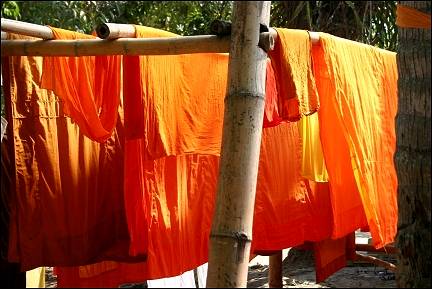
|
Bicycling in North Thailand: from Chiang Mai, where every temple tries to outdo the others with shiny goldpaint, through green hills via Doi Mae Salong in the mountainous Golden Triangle to Mae Sai, the most northern part of Thailand. Then along the Mekong River to Chiang Saen for the ferry crossing to Laos.
Travelogue & photos: Gerrie & Aart Dijkzeul
Until last week Thailand was synonymus for us with exotic landscapes, sun and heat. After a week in the north of Thailand that image has changed. It's not just peppers and papayas that grow in the fields, but also cauliflowers, chrysantemums, onions and other crops that grow close to our home.
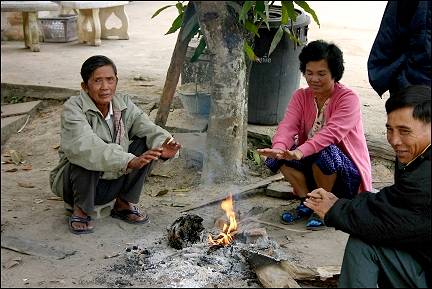
|
Add to this the morning fog and temperatures that make the Thai wear woolen caps and gloves. Not what one would expect in this country at all, but it's the reality.
It seems worse than it is, though. The Thai already shiver with temperatures around 15 degrees Centigrade. And when the sun breaks through the fog around 9 AM, the temperature rises to 25 degrees Centigrade within an hour. Perfect for bicycling.
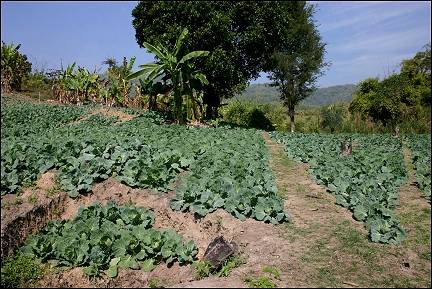
|
And that's what we've been doing over the last week. We have bicycled 200 kilometers to the North. From Chiang Mai, where we arrived, to Mae Chan. This town lies on the edge of the famous Golden Triangle, the area in Thailand, Laos and Burma where, until a few years ago, huge quantities of poppies were grown.
They have been replaced with broccoli and other less exciting crops, thanks to the Crop Substitution Program, executed with the support of Thailand's king.
Chiang Mai
The temples shine with gold paint.
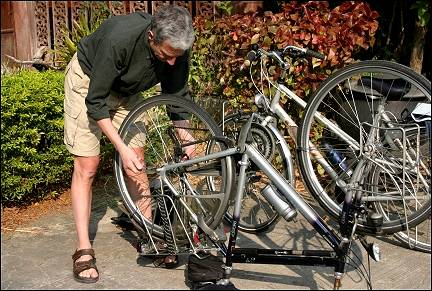
|
The flight and arrival at the airport go smoothly. A taxi driver is waiting for us with a sign with the for him unpronouncable name "Dijkzeul." The bicycles are loaded on the open back of the car. The cab doesn't take us to the luxury hotel with pool where we have reservations. He says it's full.
That sounds incredible: we booked half a year ago. He drops us at a different hotel, at a beautiful location and built with teakwood.
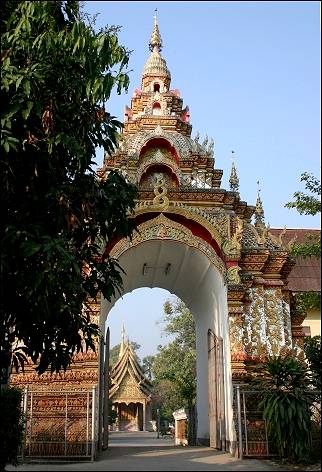
|
First we unpack our bicycles. Soon we find out that they have been damaged during transport. One has a broken spoke, which means the hind sprocket must be removed. This can only be done with special tools. The other bicycle's sprockets are stuck, it probably bumped into something.
There is nothing we can do but take the two wheels and go out to find a bicycle repair place. After wandering and asking around for a long time, we find one. The wheel with the broken spoke we can pick up after two hours (the repair costs 40 bath, a little over a dollar), the other wheel we can pick up tomorrow (the repair costs 150 bath). He's happy, we're happy, because a bicycle vacation without bicycles isn't much fun.
New Year's Eve we explore Chiang Mai, a fun city with many Wats (temples). They all try to outdo the others with shiny goldpaint. We visit a lot of them. With long skirt and wide pants. One has to look good after all when one faces the Buddha.
In front of the temples Thai walk up and down with birds in cages. For a few bath they are set free. Seems to bring good luck. Smart idea: catch birds and release them for a fee.
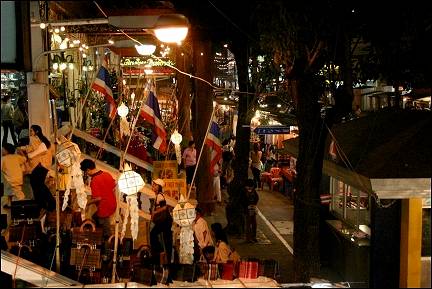
|
In the evening we visit the Night Market, a crowded neigborhood with stores and stalls that sell almost everything for next to nothing. Purses, jewelry and CDs wink at us. We have to restrain ourselves, because we don't have much room in our bicycle bags.
There is also good food. But no cozy restaurants: instead there are plastic chairs and tables on the sides of the street.
Doi Mae Salong
Blossoming trees and plants, alternated with crop fields.
We rise early on New Year's Day, because we have a long trip ahead of us. We have to get used to riding on the left, but soon we pick up speed.
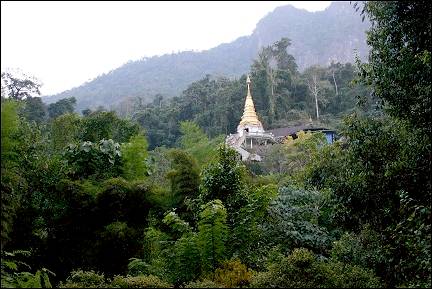
|
This region has beautiful landscapes: slightly hilly, green, many blossoming trees and plants, alternated with fields of rice, potatoes, corn, chrysantemums and cauliflower.
After three days the landscape changes. The hills are higher, some are even mountains. We sweat. On Tuesday, January 6th, we ride from Tha Ton to Doi Mae Salong, at the center of the Golden Triangle. A distance of 45 kilometers. We leave late, around noon, because we want to explore Tha Ton.
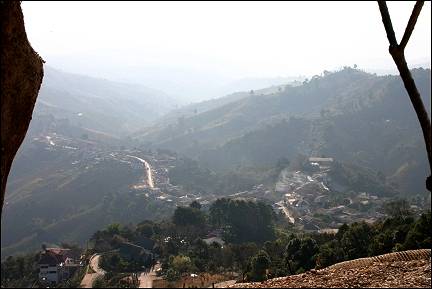
|
On the way we visit a mountain tribe village on a hill. Always fun, the Thai take on traditional garb. We leave at 4 PM for the last 16 kilometers, described as a difficult ascent.
It is the mother of all stretches. It takes us three hours to cover the short distance. It's hell. Even in lightest gear we don't move. At least not enough to stay on our bikes.
So we walk. That isn't easy either. Even now we hardly get our bikes pushed up the hill. The mountain isn't even that high, 1550 meters. What really gets us is that every time we've reached a highest point, the road descends and then the climbing starts all over again. Three times we have to ascend 2-3 kilometers and three times we descend again. Our brakes are on fire.
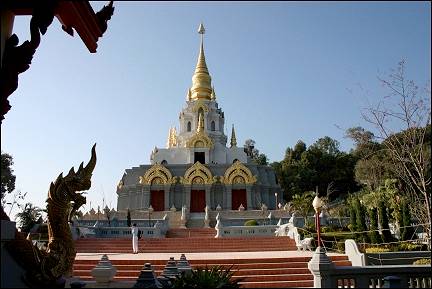
|
Half an hour after dark (and it's dark: there are no streetlights) we arrive around 7 PM at our destination. We find a hotel, take a shower, eat and feel much better.
Next day we explore the village. Everything here is Chinese: the people, the signs, the food. According to the Lonely Planet Doi Mae Salong was founded by the offspring of a Quomintang regiment. After the lost battle with the communists the Quomintang soldiers ended up in Burma, where they were expelled 20-30 years ago and then went to Thailand.
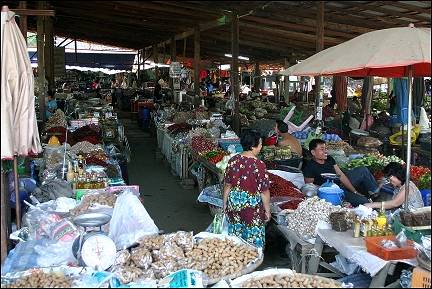
|
We continue our trip. According to the map it's best to go back the last 16 kilometers. That is not an attractive idea. So we take a taxi van with our bikes tied on the roof. Not cool, but very pleasant.
When the mountains become hills again, we mount our bikes and ride some 40 kilometers. We're mostly descending, in a gorgeous landscape. We spend the night in Mae Chan.
Mae Sai
Soldiers guard the thing from foxholes
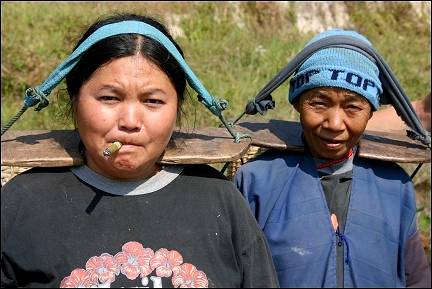
|
Our second week in Thailand. From Mae Chan naar Mae Sai, the most northern town of Thailand. After that, we bicycle along the border of Burma and later along the Laotian border via Chiang Sean to Chiang Khong, where we cross the Mekong into Laos.
It's a week with plenty of beautiful views. Green hills, wonderful nature and small-scale agriculture. The best part is riding our bikes along the Mekong river, which flows between some serious hills. Forests with teak, bamboo and meters high grass alternate.
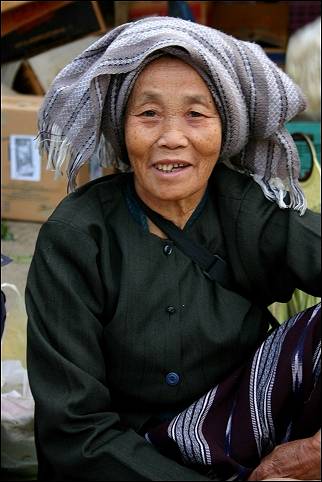
|
Als brightly colored birds and small-scale agriculture. Peanuts, beans, corn and tobacco. En of course rice paddies. Hundreds of them, a few hundred meters in surface, surrounded by dams. The only think that's missing is rice. There is only stubble. When we dismount, it's perfectly quiet, except for some birds.
Mea Sai, the most northern part of Thailand. We stay in a vacation home, a reed hut, along the Measai river. Wade forty meters in shallow water and you're in Burma.
Burma has vastly different images associated with its name. Unspoilt nature, rich culture and friendly people. The other image is of a country that is cut off from the rest of the world by a wrong-headed political system and violation of human rights.
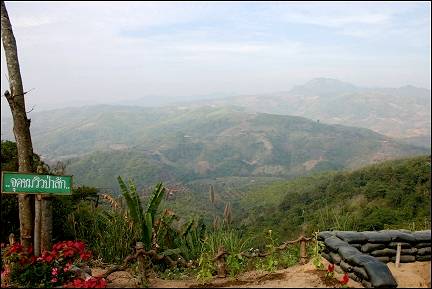
|
Opposition groups which operate from Thailand and Burmese who enter Thailand illegally are among the reasons there is such a strong presence of police and army here.
When we are bicycling in the surroundings of Mea Sai and have just reached the top of a hill, soldiers are lying in wait for us in foxholes. We show our passports and can continue.
We bicycle over a range of hills where we see Burma to the west and Thailand to the east. About two kilometers ahead there's another army post. In other places there are often police cordons. It doesn't diminish the beauty of the surroundings.
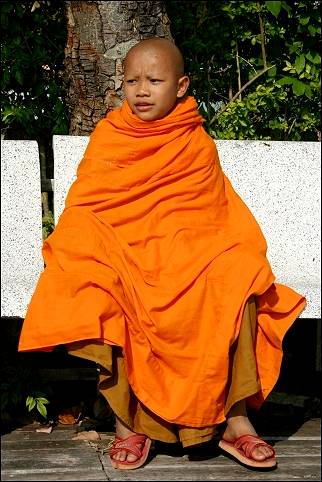
|
This is not our first experience of the special relationship between the two countries. Yesterday night, just when we went to sleep, we heard noise coming from the river. Voices and water splashing. It turns out that near our hut is a trafficking route. Bags and cans are brought by rafts, made of tires, from Thailand to Burma.
In the morning there's traffic the other way. Groups of Burmese wade to Thailand; some of them with their bicycles on their heads. Probably for illegal labor. When we ask the owner of our hut how this can happen less than half a kilometer from the official border crossing, he says that, for a little amount of money, the police sleeps at night.
Mae Sai's main street is filled with stalls and stores, an ant heap of people. In a cross street we find an oasis of quiet.
Wandering we reach a gate behind which we see the head of a Buddha statue. When we peek through the fence, a woman opens it and invites us to come in. She is a sculptress and shows us all kinds of Buddha sculptures: Statues as tall as three people and others minuscule. Even though she doesn't speak a word of English, we think she understands our "Aah" and "beautiful".
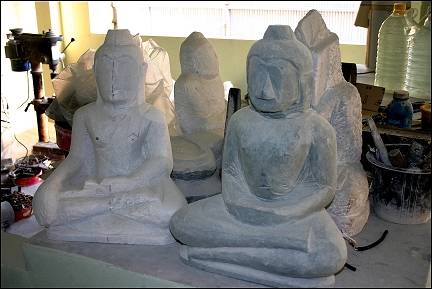
|
We are a little embarrassed when she offers us two amulets with Buddha images and also invites us for coffee. We would love to buy one of those beautiful sculptures, but that would be impractical. Can you imagine us with a big statue on the back of a bicycle riding in Laos?
It would probably be a lucky charm, but even without the statue climbing the mountain wasn't easy. But she has no intention of selling us anything. She shows us her workshop, where during the day four people are grinding and polishing sculptures. She wants us to take her picture, posing next to a three meters high Buddha statue.
Chiang Saen
Boats for China are loaded with manpower
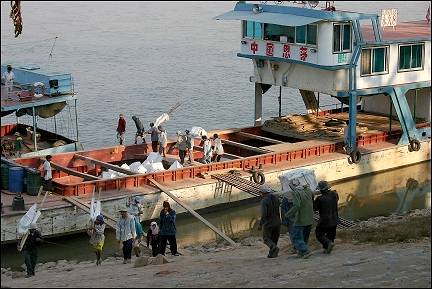
|
On Saturday we reach Chiang Saen, a city on the Mekong. Boats with destination China are loaded. Not with cranes or conveyer belts, but with manpower.
Tens of people walk in groups of four with "stretchers" on their shoulders up and down the stairs to load the ship with... well, we don't find out what. The carriers are nice enough, but their English and our Thai is insufficient.
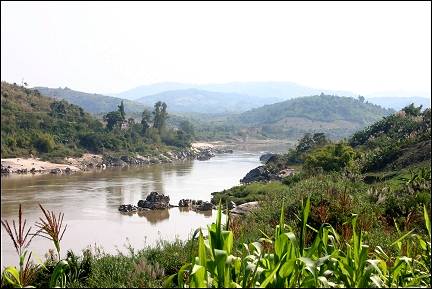
|
On Sunday we bicycle from Chiang Sean to Chiang Kongh. While we're leaving, around 8 AM, in the center of town the cockfights begin. Men but also women want their pictures taken with their cocks. The cocks display what they are known for: macho behavior.
Early morning is also the time for the tobacco harvest. Big green leaves, sometimes withered, are picked. When we ask a Thai who is busy with the leaves if this is tobacco, he invites us to take a look outside his house.
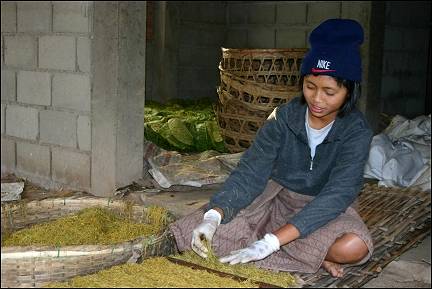
|
The whole family, young and old, are busy processing the tobacco leaves. They cut them to threads, drape those over racks which are placed in the sun to dry. It doesn't smell like tobacco at all.
Monday we ride in the surroundings of Chiang Kongh. To get used to Laos, where we're going next, we don't use the paved through roads, but local ones, often not paved. A problem is that there are no detailed maps. When we have no idea which way to go to get back to Chiang Kongh, we take the same way back. Just a matter of following the prints of our tires on the quiet, dusty roads.
On the way we see all kinds of home-made merchandise. Brooms and brushes of all kinds and sizes, made of bamboo and grass, roofcoverings made of reed, small sticks for incense are made of large bamboo sticks. Crafts that you only see at crafts fairs in the West.
Our visas for Laos don't take much time: yesterday at four we brought our passports and this morning at 8 AM they were delivered to our hut with the visas. Nothing can stop our trip to Laos anymore.